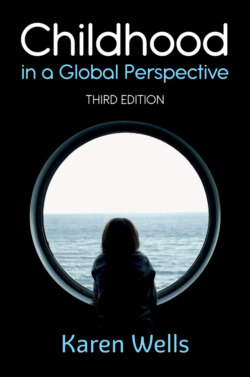Childhood in a Global Perspective

Реклама. ООО «ЛитРес», ИНН: 7719571260.
Оглавление
Karen Wells. Childhood in a Global Perspective
CONTENTS
Guide
Pages
Childhood in a Global Perspective
Dedication
1 Childhood in a global context. Introduction
Is there a global form of childhood?
The new social studies of childhood: childhood is socially constructed and children have agency
Sociology of childhood
History of childhood
Social and cultural geography
Organization of the book
Recommended further reading
2 Policy and practice. Introduction
Rescuing children: the history of child-saving
From child-saving to child rights
Embedding child rights in national and international law
UN Convention on the Rights of the Child
International development
Summary
Recommended further reading
3 Race, gender and class. Introduction
Gender
Gender socialization
Doing gender
Global circuits of care and gendered childhood
Childhood and the globalization of race and racism
The impact of racial capitalism on children’s lives in the USA
Family life
Public violence
Social psychology and theories of racial identification
Social psychology and childhood innocence
In-group, out-group
Learning the first R: school studies of race and racism
The intersections of class, race, gender and age
Summary
Recommended further reading
Notes
4 Families. Introduction
The governance of the family. The public and the private
How the law shapes family life
Governing the family through welfare and health policy
Family planning
Work
Social reproduction
Children in public. Street children
Keeping children off the street: city curfews
Transnational adoption
The Hague Convention and the UNCRC
Poverty and the circulation of children
Summary: the family in public
Recommended further reading
Notes
5 School and work. Introduction
Education and globalization. The impact of education on economic development
The impact of education on human capital
Working children. How many children are working and where are they working?
Gender and children’s work
Who decides if children work?
Why do parents put their children to work?
If children don’t go to work, do they go to school?
The impact of children’s work on human capital
Impact of work on school attendance and achievement
Impacts on health
Future consequences of working
Impact on labour markets
Summary on working children
The impact of schools: schools as a moral technology
From religious to moral education
English literature
Literacy
Summary
Recommended further reading
6 Play. Introduction
Autonomous childhood cultures?
Makeshift toys
The toy industry: from local to global
Global toy marketing
Changing material cultures of play: from wood to metal and plastic
Market segmentation
Digital play
MMOGS
Is social networking play?
Digital divide
Summary
Recommended further reading
7 Politics. Introduction
Youth and generation
School and university as sites of political mobilization
Political mobilization and generational conflict
Young moral guardians
Environmental activism as a moral crusade
Youth, political mobilization and the role of social media activism
Black Lives Matter
March for Our Lives
Summary
Recommended further reading
Notes
8 War. Introduction
Contemporary war
Failed states at war. The neo-liberal state
The neo-patrimonial state in sub-Saharan Africa
Failed states in the Middle East
Illegal trade and the funding of insurgency
Children at war
Child recruitment
Generational resentment and conflict in Africa
Poverty and child recruitment
Disarmament, demobilization and reintegration
Living with trauma. Gender and sexual violence
PTSD
Social ecology
Spiritual healing
Summary
Recommended further reading
9 Juvenile justice. Introduction
Between welfare and crime: the origins of juvenile justice
Restorative justice models and juvenile justice
The UNCRC and other international guidelines on juvenile justice
Beijing Rules
The Havana Rules
The Riyadh Guidelines
Detention
Summary
Recommended further reading
Notes
10 Migration. Introduction
Migration and parent–child separation. Global care chains
Southeast Asian parental migration
Child circulation and child fosterage in sub-Saharan Africa
Private fostering
Migration through transnational adoption and ‘social orphans’
Independent child and youth migration
Migration for work and transitions to adulthood
Social networks and migration journeys
Child labour trafficking and migration
Asylum seekers and refugee children
Summary
Recommended further reading
Notes
11 Rescuing children and children’s rights. Introduction
What is social reproduction?
Rescuing children
Rescuing street children
Rescuing child soldiers
Rescuing children in failing families
Rescuing children: the impact on children’s lives
The rights of cultures and the rights of children. Child-saving: an ethical imperative?
Child-saving: a neo-imperial intervention?
Child-saving: ethically defensible but impractical?
Rights-based approaches to rescuing children
Summary
Recommended further reading
References
Index. A
B
C
D
E
F
G
H
I
J
K
L
M
N
O
P
Q
R
S
T
U
V
W
Y
POLITY END USER LICENSE AGREEMENT
Отрывок из книги
Third edition
KAREN WELLS
.....
This book addresses that task through showing how a particular model of childhood, one that originates in contemporary Western ideas about what it means to be human and what differentiates children from adults, is being globalized through international instruments and global capitalism. This model of childhood constructs healthy childhood as one that orientates children towards independence rather than interdependence and towards school-based rather than work-based learning, and separates them from the wider forces of politics, economy and society. I call this model of childhood ‘neo-liberal’ because of the compatibility between liberal ideas that value independence, rational choice and autonomy, and the concept of childhood inscribed in this model.
In the following chapters I explore the tensions between this globalizing model of childhood, the circumstances of children’s lives, and local conceptions of childhood and of children’s competencies, capacities and vulnerabilities. I do this through exploring how global flows and international structures press down on childhood in key domains of children’s lives (family, work, school and play), how children interact directly with the state in politics, war and juvenile justice, and the strategies (especially migration) that children and their families deploy to make life possible in a globalizing world. In the next chapter I expand on the role of the state, philanthropists and non-governmental organizations (NGOs) in the reshaping of childhood in the discursive shift from child-saving to child rights.
.....